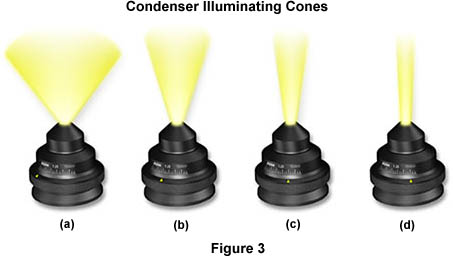

The condenser aperture diaphragm is responsible
for controlling the angle of the illuminating light cone and, consequently,
the numerical aperture of the condenser. This concept is illustrated in
Figure 3, where a series of condensers are illustrated with light cones
(and numerical apertures) of decreasing size from left to right
in the figure. Condenser light cone shapes are also a
function of the degree of correction for optical aberration.
It is important to note, with respect to the size
and shape of condenser light cones, that reducing the size of the field
diaphragm only serves to slightly decrease the size of the ower portions
of the light cones illustrated in Figure 3. The angle and numerical aperture
of the light cone remains essentially unchanged with reduction in field
diaphragm size. Another important concept, often overlooked by novices,
is that the intensity of illumination should not be controlled through
opening and closing the condenser aperture diaphragm, nor by shifting the
condenser axially with respect to the
optical center of the microscope. Illumination intensity
should only be controlled through the use of neutral density filters placed
into the light path or by reducing voltage to the lamp (although the latter
is not usually recommended, especially for photomicrography). To
ensure the maximum performance of the tungsten-halide lamp, refer to the
manufacturer's instrument manual to determine the optimum lamp voltage
(usually 6-10 volts) and use that setting. Brightness of the illumination
can then be easily controlled by adding or removing neutral density filters.